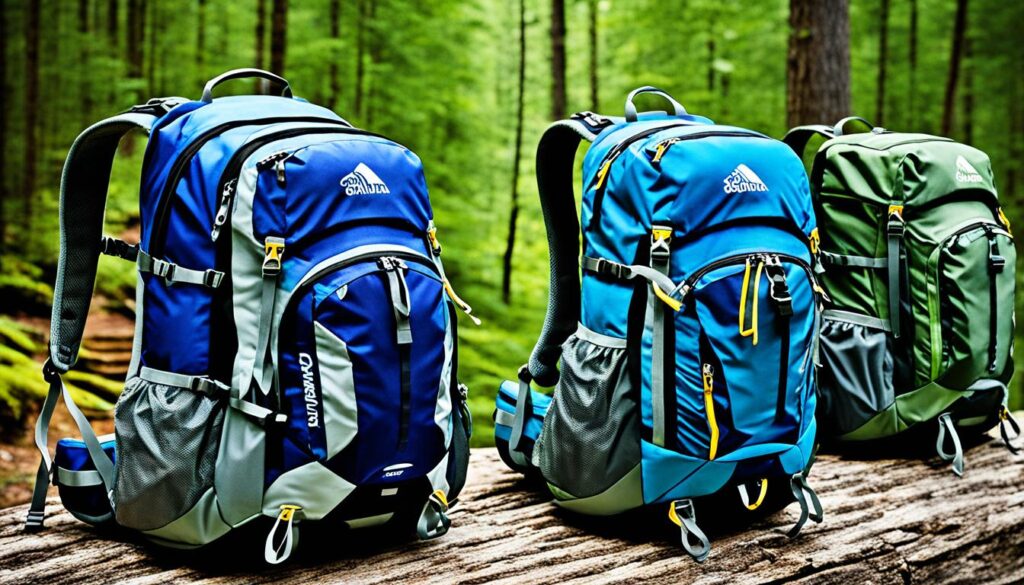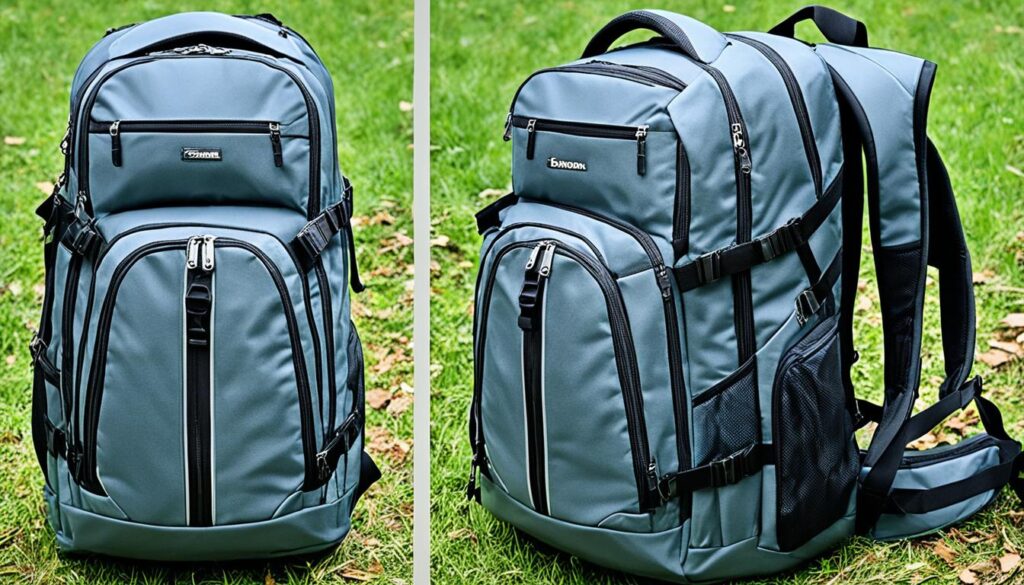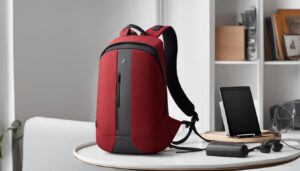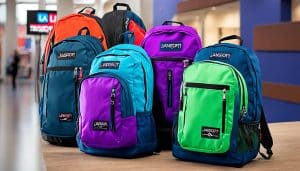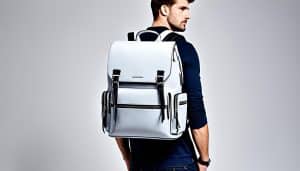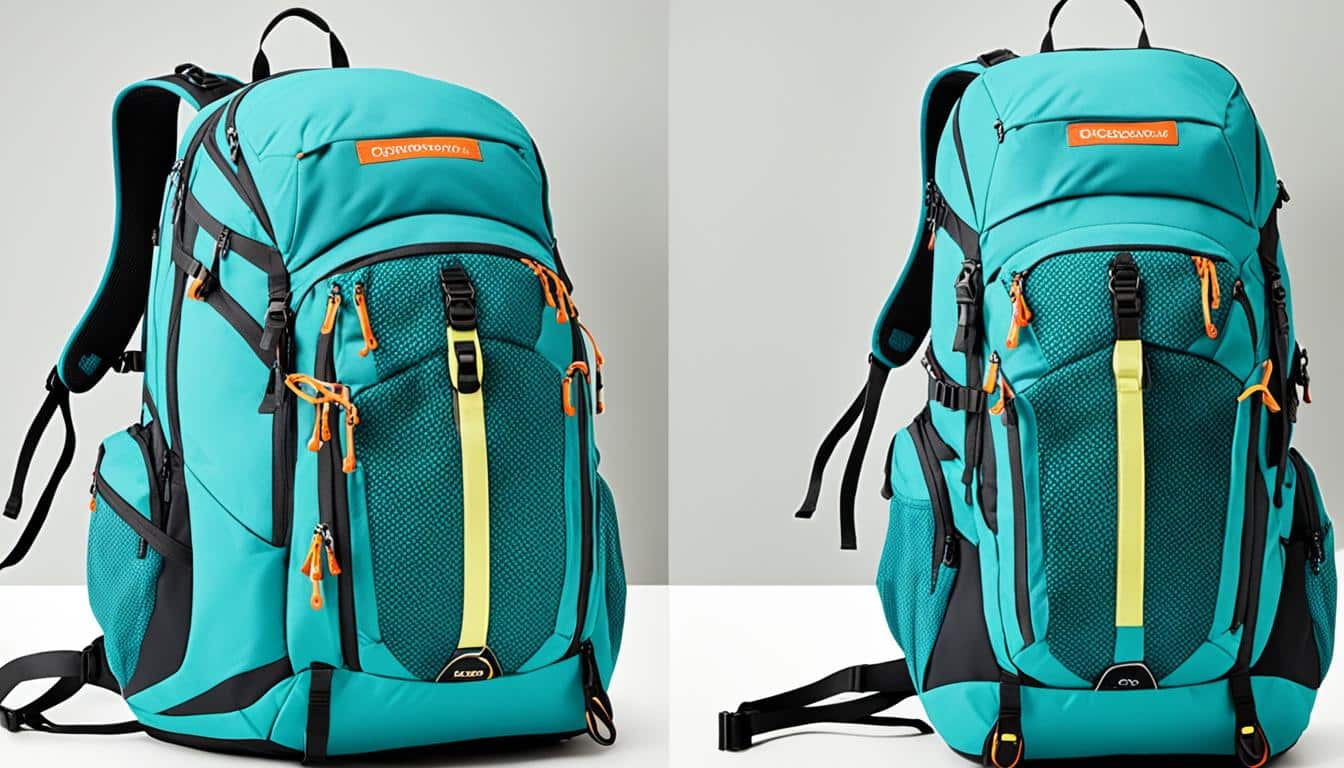
Choosing the right backpack capacity is crucial for ensuring comfort and convenience during your adventures. Whether you’re a frequent traveler or someone who needs a reliable backpack for everyday use, understanding how to choose the right size is essential. In this comprehensive guide, I’ll demystify the process of selecting the perfect backpack capacity by examining the importance of size, how backpack size is measured, common backpack sizes by use, and the benefits of an expandable backpack. By the end, you’ll have all the information you need to make a well-informed decision when it comes to backpack capacity.
Key Takeaways:
- Choosing the right backpack capacity is crucial for comfort and convenience.
- Backpack size directly affects weight and the ability to carry all your essentials.
- Backpacks are measured in volume, usually expressed in liters or cubic inches.
- Common backpack sizes vary based on their intended use.
- Expandable backpacks offer flexibility and adaptability for different purposes.
Why Size Matters
The size of your backpack matters because it directly influences your comfort and convenience while carrying your essentials. Choosing a backpack that is too large can lead to unnecessary weight and the tendency to overpack, while a backpack that is too small may not be able to hold everything you need. Finding the right size ensures that you can comfortably carry your belongings without straining your back or feeling overwhelmed. It’s crucial to strike a balance between having enough space to accommodate your essentials and keeping the weight manageable.
How Backpack Size Is Measured
Measuring backpack size is not as straightforward as it may seem. Backpacks are typically measured by their volume or capacity, which is expressed in liters or cubic inches. To determine the backpack’s volume, most reputable brands use standards set by organizations like the American Society for Testing and Materials (ASTM).
“Backpacks are designed to efficiently carry and organize your belongings. To ensure consistency and accuracy in measuring backpack capacity, brands follow established guidelines like those set by ASTM. These guidelines involve filling all fully enclosed pockets and compartments with either plastic balls or water in order to measure their volume.”
ASTM standards require that the backpack’s pockets and compartments be completely filled during the measurement process. However, it’s important to note that not all brands adhere to the same measurement methods. Some brands may include the volume of pockets that are not fully zipped, leading to potential discrepancies in reported capacities.
Understanding how backpack size is measured can help you make an informed decision when selecting a backpack. It is important to consider your specific needs and usage requirements when comparing backpack capacities across different brands.
Common Backpack Sizes by Use
Backpack sizes can vary depending on their intended use. Understanding the common backpack sizes by use can help you determine which size is best suited for your specific needs.
Here are some examples of common backpack sizes:
| Backpack Size | Capacity (liters) | Intended Use |
|---|---|---|
| Daypack/Small Backpack | 15-24 | Exploring cities or going on one-night trips |
| Medium Backpack | 24-35 | Work purposes and overnight trips |
| Large Backpack | 30-45 | Carrying a lot of stuff or a large laptop, suitable for overnight trips of 3-4 days |
As you can see, backpack sizes vary to accommodate different needs. Whether you’re exploring a city, going on a short trip, or need a backpack for work purposes, there is a size that suits your requirements. The capacity of each backpack size is measured in liters, helping you gauge how much it can hold.
When choosing a backpack, consider the purpose and duration of your trip. Smaller backpacks are great for day trips, while medium-sized ones offer more space for work essentials and overnight stays. Large backpacks are ideal for longer trips where you need to carry more items.
The Benefits of an Expandable Backpack
Expandable backpacks provide a range of benefits, making them a popular choice for travelers and individuals who value convenience. These backpacks, such as the Knack Pack, feature a main compartment that can expand or contract to accommodate varying amounts of belongings.
One of the key advantages of an expandable backpack is its versatility. With the ability to adjust the capacity, you can use the same backpack for different purposes. Whether you’re using it for work, travel, the gym, or everyday use, the expandable feature ensures that you have ample space for all your essentials. This eliminates the need to invest in multiple backpacks, saving you both money and storage space.
Another benefit of an expandable backpack is its flexibility. The adjustable capacity allows you to adapt to changing needs effortlessly. For example, when traveling, you may need a larger backpack to accommodate souvenirs or extra clothing on your return journey. With an expandable backpack, you can conveniently expand the capacity to meet these requirements without the hassle of carrying an additional bag.
An expandable backpack offers the convenience of being able to carry different amounts of belongings without sacrificing comfort. When you have fewer items to carry, you can contract the backpack to a smaller size, making it more compact and lightweight. On the other hand, if you need to carry more items, you can easily expand the capacity to accommodate them.
Overall, the benefits of an expandable backpack are twofold: versatility and flexibility. By providing the option to adjust the capacity based on your needs, these backpacks offer a practical and efficient solution for individuals who require a single pack for various purposes. With an expandable backpack, you can seamlessly adapt to different situations without compromising on comfort or convenience.
Choosing the Perfect Backpack Size
Choosing the perfect backpack size is essential for a comfortable and hassle-free travel experience. To ensure you select the right size, there are several important factors to consider:
Determine Trip Duration and Type
Firstly, consider the duration of your trip and the type of travel you’ll be undertaking. A weekend getaway may only require a smaller backpack, while an extended trip or multi-day hike may necessitate a larger capacity. By assessing the length and nature of your journey, you can better gauge the appropriate size of backpack to accommodate your needs.
Consider Activities and Special Requirements
Think about the activities you’ll be engaging in during your journey and any special requirements you may have. For example, if you plan on hiking, you’ll need a backpack that can comfortably carry necessary gear such as a tent or hiking poles. If you have specific equipment or accessories, ensure the backpack has suitable compartments or attachment points to accommodate them.
Account for Climate Variations
Climate considerations are also important when selecting the right backpack size. Different climates require varying types of clothing and equipment. If you’ll be traveling through different weather conditions, make sure the backpack has sufficient space for packing appropriate clothing layers and accessories. Consider the bulkiness of winter clothing or the need for rain gear.
Think About Accessibility
Accessibility is another crucial factor to consider. Reflect on how easily you want to access your belongings within the backpack. If you prefer quick and convenient access, choose a backpack with multiple compartments, external pockets, or a front-loading design. Additionally, consider the ease of accessing frequently used items such as water bottles, cell phones, or snacks.
By carefully evaluating these factors, you can narrow down your options and choose the perfect backpack size that suits your specific needs. Remember, the right backpack size can greatly enhance your overall travel experience.
“Choosing the right backpack size is crucial for ensuring comfort and convenience during your adventures.”
— Travel Essentials Magazine
| Factors to Consider | Recommended Backpack Size |
|---|---|
| Trip Duration | Weekend Getaway: Smaller Backpack Extended Trip: Larger Backpack |
| Activities and Special Requirements | Hiking: Backpack with Gear Attachment Points Work Commute: Laptop Compartment |
| Climate | Varied Weather: Space for Layered Clothing Harsh Conditions: Room for Specialized Gear |
| Accessibility | Multiple Compartments or External Pockets |
How to Measure and Determine Your Ideal Backpack Size
When it comes to choosing the right backpack, finding the ideal size is crucial for a comfortable and stress-free experience. By measuring and determining your backpack size accurately, you can ensure that it fits perfectly and meets your needs. Here are the steps to help you measure and determine your ideal backpack size:
- Measure your torso length: Start by measuring your torso length from the base of your neck to the point where your spine meets your lower back. Use a tape measure or have someone assist you for accurate results. Make sure to stand straight and avoid slouching during the measurement process.
- Consult manufacturer’s sizing charts: Once you have your torso length measurement, refer to the manufacturer’s sizing charts. Different backpack brands may have their own sizing guidelines, so it’s essential to find the one that corresponds to your measurements.
- Try on backpacks whenever possible: While measurements can provide a good starting point, it’s always recommended to try on backpacks before making a final decision. Visit a store that carries a wide range of backpacks and wear them to assess the fit, comfort, and adjustability. Pay attention to how the backpack sits on your shoulders, hip belts, and sternum straps.
By following these steps, you can accurately measure and determine your ideal backpack size. Remember, a properly fitting backpack ensures optimal weight distribution and reduces the risk of strain or discomfort during your adventures.
Note: It’s important to note that the process of measuring and determining the ideal backpack size may vary slightly depending on the brand and backpack type. Always refer to specific manufacturer guidelines for accurate sizing information.
Conclusion
Choosing the right backpack capacity is crucial for a comfortable and convenient travel experience. By understanding the importance of size, how backpack size is measured, common backpack sizes by use, and the benefits of an expandable backpack, you can make an informed decision when selecting a backpack. Considering factors such as the duration of your trip, type of travel, activities, climate, and accessibility will help you choose the perfect backpack size.
Remember that the right backpack size can make all the difference in enhancing your travel experience. A well-fitting backpack that meets your specific needs will ensure that you can comfortably carry your essentials without straining your back or feeling overwhelmed. By following the steps to measure and determine your ideal backpack size, you can find a backpack that accommodates your belongings and suits your travel style.
In conclusion, take the time to consider your requirements and evaluate the different backpack capacities available. Whether you opt for a small daypack or a large backpack for extended trips, selecting the right size is essential for a successful and enjoyable journey. So, make your choice wisely and embark on your next adventure with confidence, knowing that you have the perfect backpack capacity to support your needs.
FAQ
Why is the size of your backpack important?
The size of your backpack directly impacts your comfort and convenience while carrying your essentials.
How is backpack size measured?
Backpacks are typically measured by their volume or capacity, expressed in liters or cubic inches.
What are the common backpack sizes by use?
Common backpack sizes include daypacks/small backpacks (15-24 liters), medium backpacks (24-35 liters), and large backpacks (30-45 liters).
What are the benefits of an expandable backpack?
Expandable backpacks, like the Knack Pack, allow you to adjust their capacity based on your needs, offering versatility and flexibility.
What factors should I consider when choosing the perfect backpack size?
Factors to consider include the duration and type of trip, activities, climate, and accessibility needs.
How can I measure and determine my ideal backpack size?
Measure your torso length and refer to the manufacturer’s sizing charts, or try on backpacks for a proper fit.
Source Links
- https://knackbags.com/blogs/one-bag-blog/the-comprehensive-guide-to-backpack-sizes-and-liters
- https://bagsmart.com/blogs/news/size-matters-finding-perfect-size-laptop-backpack-guide
- https://nomadsnation.com/travel-bag-sizes-explained/
